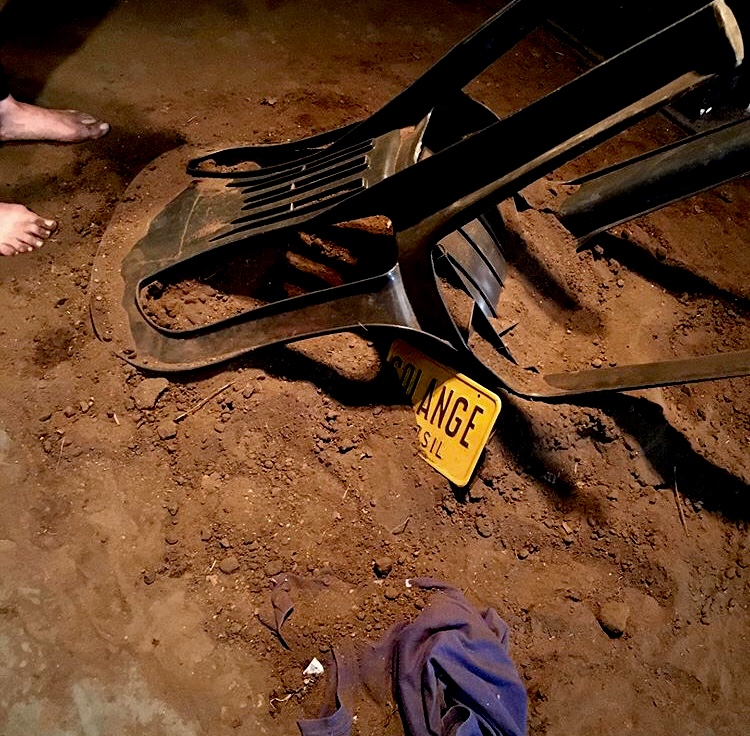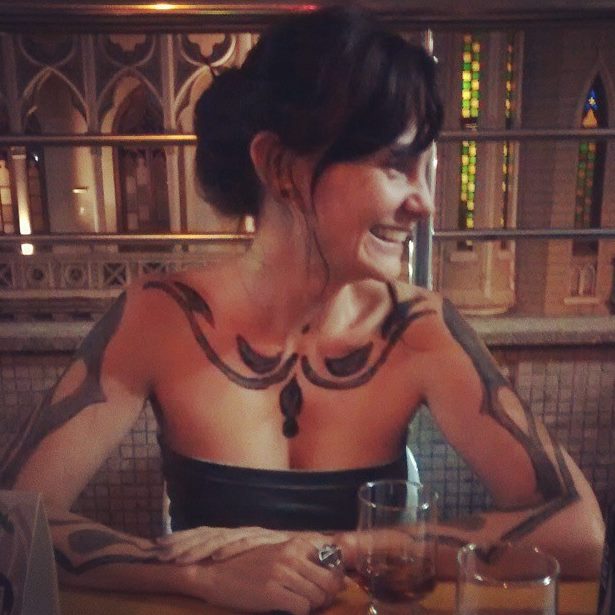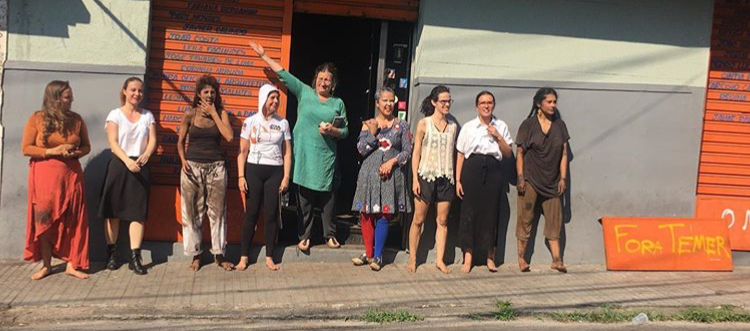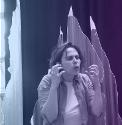About mountains and uprising: a critical report on “O Levante!”
Christina Fornaciari [1]
It is a pleasure to be invited to write about “O Levante International Festival of Women on Stage”, an event designed by the actress and director of The Train Theater Company, Lívia Gaudêncio (SP), which took place from September 9 to 15, 2019 in Belo Horizonte, Brazil.
Aiming at promoting cultural and artistic exchange between women from different countries with different trajectories, the idea, initially modest, was eventually embraced by many other women who expanded the dimension of the event, culminating in an expanded proposal. Intense programming included artistic residencies with Jill Greenhalgh (UK), Violeta Luna (Mexico) and Veronica Mato (Uruguay), performances, shows, round tables, film sessions and visual arts exhibitions involving around 80 women from a variety of backgrounds, nationalities, ages and languages.
From the first day of the event, the strong presence of this diversity led us to visit a Quilombo [2], the Kilombo Urbano Manzo. Located on the periphery of the city, this territory represents the resistance of African descendants who kept alive their cultural traditions, thanks to the strength of their women, since the quilombola culture is matriarchal. There, the participants undertook two workshops: Holy Herbs Bathing, with Mother Cassia, from Kilombo Urbano Manzo; and Abayomis Dolls [3] making - a typical toy from the slave ships - with Jana Janeiro, from Casa Quilombê.
It was interesting to realize that the ancestry of these practices sometimes found echo in contemporary artistic productions, maybe an indication that the temporal bond between these cultural manifestations can be traced from the female figure and its role in different times and places.
An example of this was the proposal of the performance "Urucum - Oracle of Demarcated Bodies". The performance provided a return to the ancient art of resorting to the Oracles to promote healing, a dive into the intimate universe of each participant and also, a dive into society. The work arises from the meeting between the Brazilian artist Lívia Gaudêncio and the Mexican performer Violeta Luna. The piece involves creation in video art, photography, dramaturgy and scene.
The performance begins in the theatre lobby, giving the audience the opportunity to offer elements that will be used during the show. Paper and pen are provided for the public, so that they can answer the question: "What violates you?" Spectators donate their own words and wounds, to be inserted poetically during the development of the performance. In Gaudencio's words: “There is no rehearsal to existance”. Earth is body. Violated body is an open wound that bleeds from generation to generation. Therefore, every meeting is an opportunity for healing.”
When we enter the theatre space, the artist is already there, covered by a long green robe that occupies the entire stage. Livia’s image reminds us of the trunk of a leafy tree. From her red hair hang bunches of annatto, which run down her long skirt. She picks them up, as if reaping her own fruits, scattering them in a circle. All movements are done very ritually. Livia spreads Tarot Cards around the stage, drawing a circle on the space, with care and a thorough knowledge of every element used there.
The texts offered by the public are read, torn and burned. On these ashes, the performer pulls out an oracle card for a collective reading. As she reads the result of the card, she performs movements and sayings that dialogue with the theme of the card. The transformation of space is an element that deserves attention, due to the radicalism with which the stage changes from a wild environment and in the midst of nature, to a human landscape, permeated by cultural symbols.
This duality – an animal, natural, irrational context and another human, cultural and rationalized - is a dichotomy that seems to cut through all the work.
In creating her own Goddess Oracle cards, Livia has become a body permeated in very old symbolisms, archetypes, and narratives that defy rational understanding by passing on an understanding derived from our ancestral memory, DNA, our animalism.
A portal of communication with the collective unconscious is open. From tree to shaman, the woman's figure embodies the connection to our deepest roots. A woman who communes with quilombola women and their tradition of valuing herbs and nature in healing processes. A woman whose actions resonates with those who, within the slave ships, had the sensitivity to worry about future generations by making Abayomis Dolls. There is some sensitive material that these women from different eras and backgrounds seek to activate. A way of existing that makes them agents of transformation and, at the same time, of maintaining the state of affairs: a powerful healing force.
Still within this idea of bringing together distinct times and spaces, the completion of “Buried” the artistic residence with Jill Greenhalgh, carried out the duality transformation-maintenance to a higher level. The artist, who is the founder of The Magdalena Project, chose to work with the word "Buried" by investigating individual responses to that word. According to Greenhalgh: “Buried memories, buried secrets, buried errors, buried bodies, buried pain, buried evidence, buried treasure. It can be a celebration of what happens when we bury seeds in the soil. Or a reflection on the burial and preservation of antiques under the lava. ”
Greenhalgh used the element “earth” during the residency, which gained a lot of strength in relation to the recent context of mud spills in the cities of Mariana and Brumadinho, in the region where the event took place. The collapse of tailing dams from mines has caused an unprecedented environmental and sociocultural tragedy [4].
Each resident artist received150kg of earth and a chair, these were the basic elements to work on and, besides these material, the residents also brought affective objects (songs, texts, clothes and other stimuli that could compose the performance). Throughout the 5 days of residence, the simple act of breathing within the scenic space was challenging and somewhat cathartic.
Was this suffering to breathe the same felt by those who were buried in Mariana and Brumadinho? Are we all buried alive in this capitalist society that puts profit before life? How to see the future when your vision is blurred by black dust?
Dealing with these memories, with these material and with the catastrophe context, gave the participants the theme for creation inevitably evolved beyond the personal / biographical limits, entering the social and political realm.
And that's exactly what happened at the end of the residency. Breathing masks were distributed to the audience due to the difficulty of breathing at the venue. Having each artist used the earth and other resources to generate installations and sculptures, spectators had to find ways to walk between them, perceiving at every moment new images, sounds and movements that emerged and interrelated in the midst of black earth.
 The spectators were transported to the chaotic universe that emerged from the word "Buried", covered by tons and tons of earth, but also permeated with symbols created by the resident artists. Using the breathing masks the spectators also performed there, were altered, transformed. Crossing the space was like walking in the dark and suddenly coming across small islands of human presence amid a large mound of black earth.
The spectators were transported to the chaotic universe that emerged from the word "Buried", covered by tons and tons of earth, but also permeated with symbols created by the resident artists. Using the breathing masks the spectators also performed there, were altered, transformed. Crossing the space was like walking in the dark and suddenly coming across small islands of human presence amid a large mound of black earth.
The route between these islands created connections between them, in a kind of requiem where feelings such as mourning, healing, reverence for the dead and, mainly, denunciation alternated. In the eyes of those present there was disgust at the predatory exploitation of natural resources, without respect for nature or human life, typical of the advancing male force, at all costs. Presence and absence, death and life, past, present, future, private and collective, personal and political are dimensions that overlap and intertwine in this open composition. The activated perceptions, beyond the discursive language, also occupied spectators’ bodies, in its sensitive and kinaesthetic dimension.
These are some of the examples - among so many! - chosen for this short text that, by far, can portray the liveliness of those days of "O Levante!". Others could be analysed in order to compare the experience of “O Levante!” with other historical moments when a group of artists decide to come together to create, strengthen, resist and endure living in times of high human vulnerability.
It is impossible not to relate “O Levante!” to the meetings at Black Montain College. Founded in the 1930s in North Carolina, USA, it involved European artists and thinkers who fled Europe during World War II, creating a space of strength and resistance amidst the scene of destruction and horror of those times. Black Mountain College artists paid attention to perception and sensitivity, brought the body to the centre of creative processes, as if regaining their value in contrast to the mountains of corpses generated by Nazi concentration camps. As at Black Mountain College, “O Levante!” promoted a barn of counterculture in wartime: oppression, disrespect for life, and crumbling feminist achievements. The moment is one of not only environmental catastrophes but loss of rights, a conservative wave that plagues everyone in backward thinking, misogyny and human rights violations. Against this, temporary gatherings such as “O Levante!” and Black Mountain College empower themselves as spaces of freedom, albeit temporary - and perhaps for that very reason, they create very intense meetings.
Elusive, because they are ephemeral, these experiences produce lasting effects on the memory and body of those who participate. They are Temporary Autonomous Zones (TAZ), to use the term coined by the American historian Hakim Bey [5]. They reverberate in time and space as they do not end when they dissipate … “O Levante! - International Festival of Women on Stage” generated a TAZ because it was a collective, horizontal construction of exchanges unmediated by the capital - the artists donated their work, free of charge, just as cultural spaces donated their structures - and free of judgment.
 Perhaps the greatest power of a TAZ is precisely to create witnesses, people who will carry and transmit the event's energy, even after the meeting has ended - like the Abayomi dolls, which survived in the Quilombos after so many centuries; like the Oracle consulting traditions, an old procedure updated by Lívia in her performance. Bringing difference and repetition, tradition and renewal, “O Levante!” provided a harmonious and non-repressive space, raising the intensity of life, something exceptional nowadays. May other editions come!
Perhaps the greatest power of a TAZ is precisely to create witnesses, people who will carry and transmit the event's energy, even after the meeting has ended - like the Abayomi dolls, which survived in the Quilombos after so many centuries; like the Oracle consulting traditions, an old procedure updated by Lívia in her performance. Bringing difference and repetition, tradition and renewal, “O Levante!” provided a harmonious and non-repressive space, raising the intensity of life, something exceptional nowadays. May other editions come!
Christina Fornaciari
November 2019
All photos by Christina Fornaciari.

1. Christina Fornaciari (Brazil, 1977) is an artist and arts teacher based in Brazil. She holds a PhD in Performing Arts from UFBA - Federal University of Bahia, and a MA in Performance from Queen Mary University of London. She teaches Performance at the Undergraduate Dance Course at UFV - Federal University of Viçosa, Brazil. Her works are developed on the interface between Performance, Theater and Installation. Her research intertwines politics, Human Rights and arts in contexts of interculturality. christinafornaciari [at] gmail.com
2. Quilombo is the name given to communities formed by descendants of enslaved Africans, who fled their masters/owners to live in freedom. Today, following the abolition of slavery, these territories retain specific characteristics of the African people subjected to slavery, from cooking habits to collective management of children inside the communities.
3. The enslaved Africans came to Brazil on large ships, called slave ships. As the trip took months and there were many children in these ships, women made the Abayomis dolls with pieces of fabric, with the intention of preserving children’s rights of to play, to cherish them, to provide moments of joy.
4. These collapses drove more than 50 million cubic meters of mud into the region, leaving five municipalities completely submerged. About 400 people were killed in this tragedy and another 200 are still missing. Investigations indicate that there was negligence on the part of mining company VALE, which is being sued for the environmental and human crime it caused.
5. Known by its acronym TAZ (Temporary Autonomous Zone), the idea of a Temporary Autonomous Zone, conceived by Hakim Bey, is how a voluntary collective of like-minded people can maximize their freedoms in today's society, forming independent networks of living and communication, thus eluding formal control structures. The book TAZ was published in Brazil by Editora Veneta within the BADERNA collection in 2018. The original English book is registered as copyleft.




